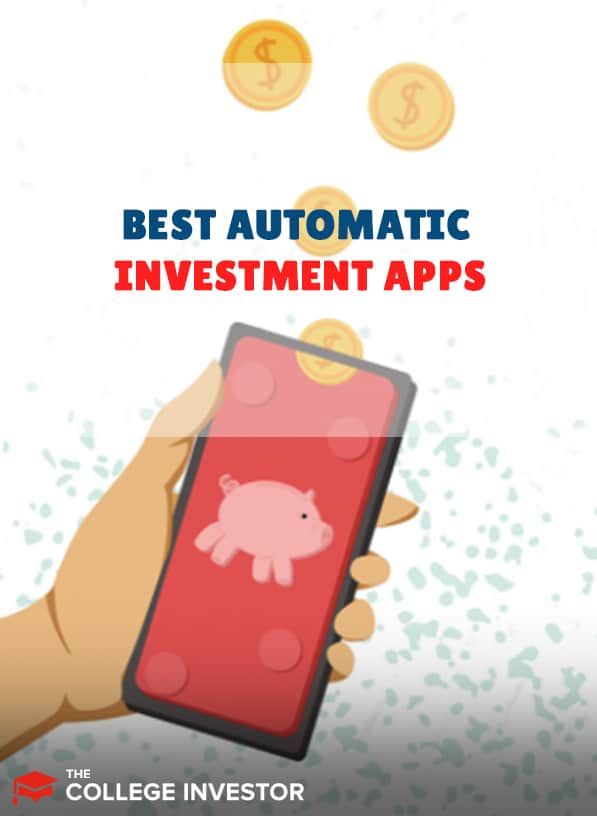
Building wealth typically requires regular savings and a disciplined approach to investing. Unfortunately, these things are easier said than done.
Thankfully, automatic investing apps make it easier for regular people to become excellent investors. They can be great "set it and forget it" options for buy-and-hold investors who aren't interested in short-term trading.
Below, we break down our top three automatic investment apps of 2024 before sharing a few more apps that didn't quite make our list but may still be worth considering.
Our Picks Of The Top Automatic Investment Apps Of 2024
After reviewing more than two dozen top brokers and micro-investing apps, we’ve narrowed down the best automatic investment apps to these three.
1. Acorns
Acorns is one of the original automated investing apps ever created. They were the first "spare change" app, where you could round up your spare change and invest. Then they started focusing on automated investing as well.
Acorns takes your roundups and automatic investing and puts it into low cost index funds so that you can see long-term growth. This is a simple "set and forget" approach, which is what most people looking for automatic investing apps are looking for!
The downside to Acorns is the fees. Sadly, Acorns isn't free - and you'll pay a monthly fee of anywhere from $3 to $5 per month depending on what plan you select.
Bonus: Right now, Acorns is offering a $20 bonus when you register an account and make your first $5 investment. Get stared here >>
2. M1 Finance
M1 Finance frequently tops our “best of” investment lists. The top-notch interface, low fees, and customizable investment pies make it a great choice for investors seeking a disciplined, but unique investment experience.
M1 Finance allows users to opt into “Auto-Invest”. With auto-invest, M1 Finance’s algorithms will rebalance your portfolio anytime you have at least $25 in cash in the account. This “smart” rebalancing automatically keeps investors more in line with their stated goals.
Since M1 Finance supports Roth, Traditional, and SEP IRAS it allows many investors to automate tax-advantaged investments. It also supports individual and joint brokerage accounts.
3. Charles Schwab Intelligent Portfolios
Charles Schwab Intelligent Portfolio is a free robo-advisory service for people with at least $5,000 in their accounts. The Intelligent Portfolio app makes it easy to set up recurring transfers to the account.
Users select from several different pre-designed portfolios that invest in 51 broadly diversified, low-cost ETFs. Whenever money hits the account, Schwab automatically invests the money to rebalance the portfolio.
However, the app also follows tax-loss harvesting laws to help minimize taxation (only for taxable accounts with balances over $50,000). This type of efficient investing is somewhat complex to do manually, so it’s nice to see the robots taking over complex but routine tasks.
The only major drawback to the Intelligent Portfolio’s app is the high cash position. Most portfolios hold between 6-30% of the portfolio in cash which can be a drag on the overall performance of the portfolio (especially when the investment horizon is several decades).
4. Wealthfront
Wealthfront is one of the most popular robo-advisor platforms currently available to investors. This is one of the most "true" automated investing platforms in the sense that it will create and automate your portfolio. Once you get your account setup, all you have to do is deposit money and it will do the rest. You can even setup recurring investments to make it happen.
Wealthfront does charge an annual management fee - which is currently 0.25% AUM. That means that you're going to pay more as you get more money invested.
5. Stash
Stash is another long-time investing app that has focused on making things simple and easy. It's probably the most direct competitor to Acorns, minus the round-up feature.
With Stash, you setup your investing goals and portfolio, and as you deposit funds, it will automatically invest to match your portfolio. They also put a premium on making it easy to invest - they simplify investing terms and make things easy.
However, you're going to pay a monthly fee to invest with Stash. You'll pay $3 to $9 per month depending on what plan you enroll in.
Promo offer: You can get $5 from Stash when you sign up and make your first deposit of at least $5 into your Personal Portfolio! Get started here >>>
Other Automatic Investment Apps To Watch
While we chose just true top automatic investment apps, there were a few that just missed the cut. These honorary mentions deserve a shout-out as they can be a good fit for certain investors.
Webull
Webull is a great app for automating active trading. With no commissions and a wealth of information, it’s a top choice for active traders. But it’s also a great place for investors looking to automate their buying.
Automating active trading may seem like an oxymoron. But in this case we mean that it allows users to set up buy and sell prices that the app then handles. This is far easier in Webull than in most apps. However, this brokerage doesn’t support fractional shares at this time.
Public
Public offers DRIP, but it doesn’t offer an obvious way to set up recurring investments at this time. Part of this may be intentional. Public wants users to buy into the social aspect of stock market investing. And automated investing doesn’t fit with that. However, we’re watching this rising star that already promotes fractional share investing and commission-free trading.
What Makes An Automatic Investing App Great?
These days most investment platforms allow some form of recurring investments. However, great automation is about more than just allowing users to automatically transfer funds to their accounts. To create our list, we considered five major criteria:
Why Don’t Micro-Investing Apps Make This List?
Micro-investing apps specialize in investing tiny amounts of money. They often give users the ability to buy fractional shares using just a few dollars at a time. They may even connect to your checking account and “roll-up” transactions to the nearest dollar and skim the extra into your investment account.
The idea behind micro-investing apps is that a little bit of savings goes a long way. In some ways, this is true. However, most people will need to invest more than spare change to achieve their long-term financial goals.
And while the fees for these apps may seem low on the surface (usually $1-3 per month), when you compare them to relatively small investment balances, they can be shockingly high. For most people, setting up a $20-$25 per week auto-transfer into one of the apps listed above will yield better results than micro-saving.
Should You Use An Automatic Investing App?
If you’re serious about building wealth, we recommend employing some sort of helpful automation to keep you on track with achieving your goals. Simple steps like setting up recurring transfers to your investment accounts can ensure you’re moving in the right direction.
People who enjoy playing around in their investment account, reading investment news, and researching new stocks probably don’t need to employ specific investing automation technologies (beyond regular savings). If this is you, you can likely trust yourself to buy new stocks and keep yourself invested.
However, those who aren’t disciplined about tracking investments and buying new shares should consider automatic investments. Life happens, but most people want to stay invested even when they can’t stay attuned to their portfolio. For those in this category, automatic investment apps are a great fit.

Hannah is a wife, mom, and described personal finance geek. She excels with spreadsheets (and puns)! She regularly explores in-depth financial topics and enjoys looking at the latest tools and trends with money.
Editor: Clint Proctor Reviewed by: Claire Tak







